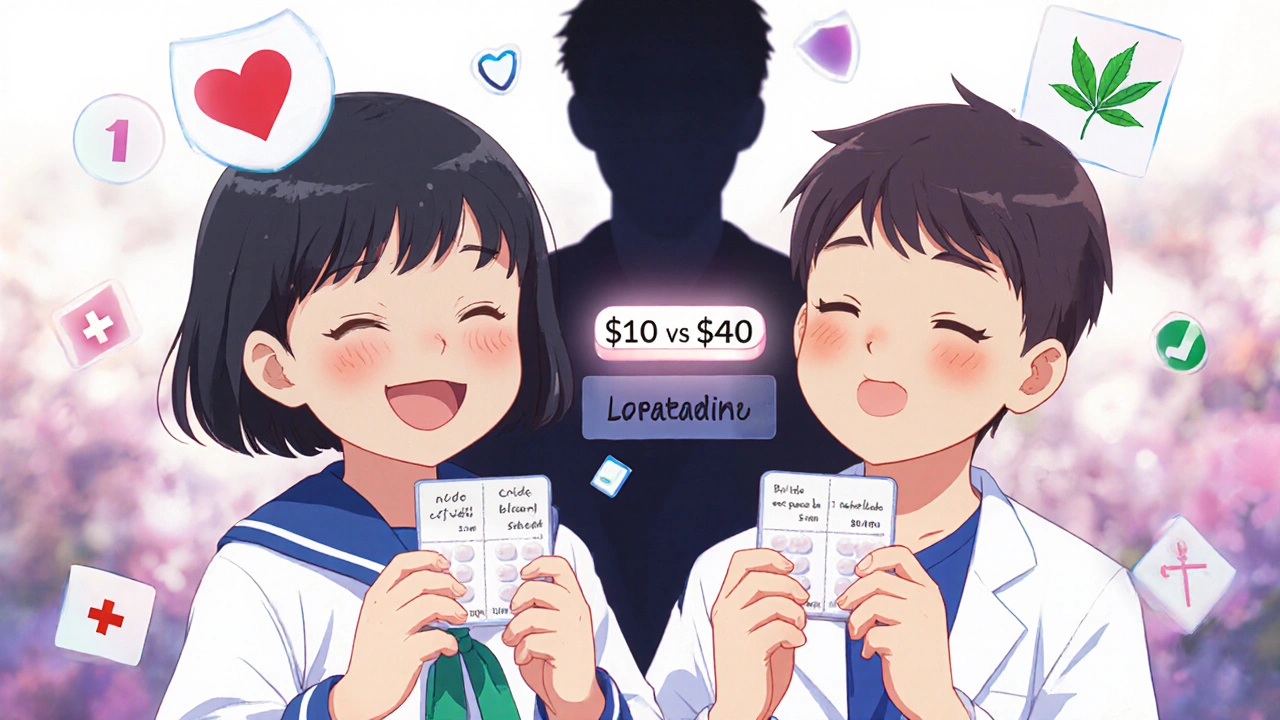When your nose is running, your eyes are itchy, and you can’t tell if it’s a cold or allergies, choosing the right antihistamine matters. Two names come up again and again: desloratadine and loratadine. Both are second-generation antihistamines, both are non-sedating, and both are sold over the counter in many countries. But they’re not the same. If you’ve tried loratadine and it stopped working-or if you’re just starting out and want to pick the best option-you need to know the real differences in dosing, side effects, and how they actually work in your body.
How They Work: More Than Just Blocking Histamine
Loratadine is the older drug, approved in the 1990s. It’s what you find on the shelf next to the cough syrup. Desloratadine? It’s not a separate invention-it’s what your body turns loratadine into. When you take loratadine, your liver breaks it down into desloratadine, which is the actual active compound doing the work. That’s why desloratadine is called an active metabolite. But here’s the key: when you take desloratadine directly, you skip the middleman. You get the full effect without relying on how well your liver processes the original drug.
And it’s not just about blocking histamine. Desloratadine does more. It reduces inflammation by calming down immune cells like eosinophils, which are behind the swelling and itching in allergic reactions. It also lowers levels of inflammatory chemicals like IL-4 and IL-13. This isn’t just theory-studies from the Journal of Allergy and Clinical Immunology in 2023 show these effects happen at normal doses. That’s why people with persistent nasal congestion or chronic hives often report better results with desloratadine. Loratadine blocks histamine. Desloratadine blocks histamine and turns down the inflammation engine.
Dosing: Less Is More
You might think more pills mean stronger effects. Not here. Loratadine is dosed at 10 mg once a day. Desloratadine? Just 5 mg. That’s right-half the milligrams, same or better results. Why? Because desloratadine is about four times more potent at the receptor level. You don’t need as much of it to get the same job done.
Both are taken once daily, but desloratadine lasts longer. Its half-life is 27 hours. Loratadine’s is around 8 hours, though its metabolite (desloratadine) sticks around longer. That means desloratadine gives you smoother, more consistent coverage. You’re less likely to feel symptoms creep back in the late afternoon or evening. For someone with allergies that hit hard at night or early morning, that matters.
Age matters too. Desloratadine is approved for kids as young as 1 year old. Loratadine? Only for children 2 and up. If you’re treating a toddler with chronic hives, desloratadine is your only option. Pediatric studies show that at 5 mg daily, kids aged 2-5 reach steady-state levels of 7.8 ng/mL-higher than controls and enough to suppress symptoms without causing drowsiness.
Side Effects: What You Actually Feel
Both drugs are labeled “non-sedating,” and for good reason. They barely cross the blood-brain barrier, so they don’t make you sleepy like old-school antihistamines (think Benadryl). But that doesn’t mean zero side effects.
Common side effects for both include dry mouth and headache. But here’s where the data splits. Multiple studies, including those from the University of Virginia and the Journal of Clinical Pharmacology, show desloratadine has a lower tendency to cause drowsiness. In fact, one trial found only 2.3% of desloratadine users reported drowsiness, compared to 4.1% on loratadine.
Some people report headaches with desloratadine more often. A few user reviews on Drugs.com mention this. But look closer: 63% of desloratadine users report positive effects, while only 54% do for loratadine. That means for every person who gets a headache, three others get better symptom control.
Diarrhea and irritability are slightly more common with desloratadine in kids-6.1% vs 2.4% for diarrhea, 6.9% vs 5.6% for irritability. But these are still low numbers. And remember, these are pediatric studies. In adults, side effects are even rarer.
One big safety win for desloratadine: it doesn’t affect heart rhythm. Loratadine, at very high doses or in people with liver problems, can slightly prolong the QT interval. Desloratadine? No effect on QRS or QTc intervals. That’s why cardiologists don’t worry about it when prescribing to older patients or those on other meds.

Who Gets Better Results?
Real-world data tells the story. On Drugs.com, desloratadine has a 7.2/10 rating from over 800 reviews. Loratadine sits at 6.3/10 from nearly 1,250 reviews. That gap isn’t small. People who switched from loratadine to desloratadine often say: “My eyes stopped itching,” or “I didn’t wake up with a stuffy nose anymore.”
Reddit threads from r/Allergies show 68% of users with moderate-to-severe allergies prefer desloratadine. The rest stick with loratadine-not because it works better, but because it’s cheaper. That’s the trade-off.
Experts agree. The European Academy of Allergy and Clinical Immunology gave desloratadine a 4.7/5 for efficacy, compared to 4.2 for loratadine. Mayo Clinic allergists say desloratadine is their go-to for patients with nasal congestion or asthma co-existing with allergies. The American Academy of Allergy, Asthma & Immunology recommends it for those who need stronger anti-inflammatory action.
But if you have mild, occasional sneezing and it’s your first time using an antihistamine? Loratadine is still a solid, low-cost choice. As Dr. Robert Naclerio from the University of Chicago points out, the extra benefit of desloratadine might not justify the higher price for simple cases.
Cost, Availability, and Practical Tips
Price is the biggest divider. In the U.S., a 30-day supply of generic loratadine costs $10-$25. Desloratadine? $25-$40. That’s a 50-100% jump. But if you’re on Medicare or have a good insurance plan, the copay might be the same.
Both are available over the counter in Australia, the U.S., and most of Europe. Desloratadine is sold under brand names like Aerius and Clarinex, but generics are widely available. Loratadine is sold as Claritin and countless store brands.
If you’ve been on loratadine for a few weeks and symptoms aren’t fully controlled, switch to desloratadine. The ACAAI recommends giving it a try after 2-4 weeks of inadequate response. No need to taper. Just swap the pill.
Food doesn’t affect either drug. Take them with or without meals. No need to time them around coffee or breakfast.
For bariatric surgery patients, desloratadine is the clear winner. Loratadine doesn’t dissolve well after surgery, meaning you might not absorb enough. Desloratadine dissolves completely in every condition. That’s not just a footnote-it’s a clinical necessity for some.

What’s New in 2025?
Recent updates from the FDA in August 2023 removed previous warnings about dosage adjustments for kidney or liver issues. Both drugs are now considered safe at standard doses even if you have mild to moderate impairment. That’s a big relief for older adults.
Prescription trends show loratadine is still the most prescribed antihistamine in the U.S.-nearly 25 million prescriptions in 2023. But desloratadine is growing faster. Market analysts predict a 4.2% annual increase through 2028, while loratadine grows at just 1.8%. More doctors are starting to see it as the better tool for persistent allergies.
And while new biologics like Dupixent are changing treatment for severe eczema and asthma, they’re expensive, injectable, and for extreme cases. For most people with seasonal allergies, runny nose, or hives? Desloratadine and loratadine are still the foundation.
Final Decision: Which One Should You Take?
Here’s how to choose:
- Choose desloratadine if: You have moderate-to-severe allergies, nasal congestion, itchy eyes, or chronic hives. You’ve tried loratadine and it didn’t fully work. You’re treating a child over 1 year old. You want the most consistent 24-hour coverage. You’re post-bariatric surgery.
- Choose loratadine if: Your allergies are mild and occasional. You’re on a tight budget. You’re trying an antihistamine for the first time. You don’t have any other health conditions that complicate absorption.
Neither drug is perfect. But if you want the most effective, longest-lasting, safest option with the broadest anti-allergy action, desloratadine is the clear leader. Loratadine isn’t obsolete-it’s just the entry-level version.
Try one. If it doesn’t give you full relief after two weeks, switch. There’s no harm in trying the stronger option. Your nose, eyes, and sleep will thank you.
Can I take desloratadine and loratadine together?
No, you should not take them together. Desloratadine is the active metabolite of loratadine. Taking both at the same time doesn’t give you double the effect-it just increases your risk of side effects like headache or dry mouth without added benefit. Stick to one or the other.
Does desloratadine make you sleepy?
Most people don’t feel sleepy on desloratadine. It’s designed not to cross the blood-brain barrier. In clinical trials, drowsiness occurred in fewer than 3% of users. Some people report mild tiredness when they first start, but it usually goes away after a few days. If you feel drowsy, avoid driving or operating heavy machinery until you know how your body reacts.
Is desloratadine safe for long-term use?
Yes. Studies show desloratadine is safe for daily use over months or even years. It doesn’t cause tolerance, meaning it won’t stop working over time. The World Allergy Organization confirms it remains a cornerstone therapy for chronic allergic conditions due to its excellent long-term safety profile.
Can I take desloratadine if I have liver or kidney problems?
Yes. As of 2023, the FDA removed previous warnings about adjusting the dose for mild to moderate liver or kidney impairment. Standard 5 mg once daily is safe for most people with these conditions. But if you have severe impairment, talk to your doctor-individual cases may need monitoring.
How long does it take for desloratadine to start working?
Desloratadine starts working within 1 hour for some people, but full effects usually take 3-5 hours. Unlike first-generation antihistamines, it doesn’t give you instant relief, but it lasts longer. Most users report noticeable improvement in symptoms like sneezing and itching within 24 hours of the first dose.
Is desloratadine better for allergy-induced asthma?
Yes. Research shows desloratadine helps reduce airway inflammation linked to allergic asthma. It’s not a replacement for inhalers, but when used alongside standard asthma meds, it can reduce flare-ups triggered by allergens. The PubMed study from 2001 confirmed its effectiveness in patients with co-existing asthma and allergic rhinitis.


Comments (10)
Richard Kang
So let me get this straight-you’re telling me I’ve been wasting my money on Claritin for years?? I just took desloratadine last week because my nose was acting like a broken faucet, and holy crap-it’s like someone turned off the allergy switch in my brain. No more 3 a.m. sneezing fits. Also, why does everyone still act like loratadine is the OG? It’s like using a flip phone in 2025.
Jessica Glass
Of course the people who swear by desloratadine are the same ones who pay $40 for a 30-day supply like it’s artisanal kombucha. Meanwhile, I’m over here saving $30 a month so I can afford my therapist. Loratadine works fine-unless you’re one of those people who think every symptom deserves a premium solution.
Rohit Nair
i just tried desloratadine after my kid got hives at 18 months-doc said loratadine not approved under 2 so we went with this. no drowsiness, no drama. just quiet, calm days. honestly? worth every rupee. also, my wife says my sneezing stopped and now she sleeps better too lol. thanks for the detailed post!
Gavin McMurdo
Let’s be honest: the entire pharmaceutical industry wants you to believe that ‘more expensive = better.’ But here’s the truth-desloratadine isn’t magic, it’s just pharmacokinetics dressed up in a lab coat. The fact that it’s an active metabolite means loratadine was always doing the heavy lifting. The real difference? Profit margins. And yes, I’ve taken both. Desloratadine lasts longer, sure. But if you’re not allergic to your wallet, stick with the $10 option. You’re not broken-you’re just being marketed to.
Lilly Dillon
I switched after two weeks of loratadine doing nothing. My eyes stopped burning on day three. I didn’t even notice until I blinked and realized I wasn’t squinting. Also, no headache. Just… peace. I’m not a medical person, but this worked. So I’m not complaining.
Peter Feldges
As someone who has lived with seasonal allergies since childhood and has consulted allergists across three continents, I must emphasize the clinical superiority of desloratadine in patients with comorbid asthma and chronic rhinitis. The anti-inflammatory modulation of IL-4 and IL-13 pathways, as referenced in the 2023 JACI study, is not merely anecdotal-it is reproducible, peer-reviewed, and clinically significant. While cost is a legitimate concern in resource-constrained settings, the long-term reduction in rescue inhaler usage and emergency visits may offset the initial expense. I prescribe desloratadine as first-line for moderate-to-severe cases, and my outcomes reflect this.
Krishna Kranthi
bro i took loratadine for years then switched to desloratadine and now my life is different like i can actually smell my coffee again instead of just breathing through my mouth like a goldfish. also i dont know why but i feel less grumpy now? maybe its the lack of constant sneezing. also why is this not in every pharmacy? its like they dont want us to feel good
Shiv Sivaguru
Why are we even debating this? It’s obvious. Desloratadine is the Tesla. Loratadine is a Honda Civic that runs on fumes. You don’t need a Tesla if you drive to the corner store. But if you’re trying to cross the country without falling asleep at the wheel? Yeah. Upgrade. Also, my dog stopped licking her paws after I started taking it. Coincidence? I think not.
Jesse Weinberger
Wait so you’re saying taking two antihistamines is bad? Newsflash: I’ve been taking loratadine and cetirizine together since 2018 and I’m still alive. Also, I think desloratadine is just a rebrand. Big Pharma doesn’t care about your nose-they care about your credit card. And don’t even get me started on ‘FDA removed warnings’-that’s just corporate PR. I’ve read the full studies. The QT prolongation risk is still there if you’re on statins. You’re just being told what to believe.
Wendy Stanford
I used to think allergies were just a nuisance. Then I realized they were stealing my joy-the quiet mornings, the smell of rain, the ability to breathe without feeling like my throat was lined with sandpaper. Desloratadine didn’t just stop my symptoms-it gave me back my life. I cried the first time I woke up and didn’t reach for the tissue box. I didn’t know I’d been holding my breath for years. This isn’t medicine. It’s a quiet kind of redemption. And yes, it’s expensive. But some things aren’t priced in dollars. They’re priced in peace.